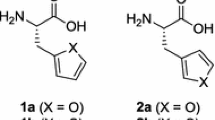Abstract
The incorporation of –SF5 group onto model amino acids has been achieved using commercially available synthons substituted with this group. This work investigates the influence of the –SF5 group on a variety of common synthetic transformations utilized in fields of bioconjugation and drug development, namely, amide coupling, reductive amination, diazo-coupling, and CuAAC “click” reactions. The influence of the novel substituent on the success of these common transformations is presented, and alternative approaches for those which proved unsatisfactory are proposed herein.
Graphic abstract


Similar content being viewed by others
References
Silvey GA, Cady GH (1950) J Am Chem Soc 72:3624
Lentz D, Seppelt K (1999) The –SF5, –SeF5, and –TeF5 Groups in Organic Chemistry. In: ChemInform, vol 30. Wiley Online Library. https://doi.org/10.1002/chin.199927312
Sheppard WA (1962) J Am Chem Soc 84:3072
Sowaileh MF, Hazlitt RA, Colby DA (2017) Chem Med Chem 12:1481
Wipf P, Mo T, Geib SJ, Caridha D, Dow GS, Gerena L, Roncalc N, Milnerc EE (2009) Org Biomol Chem 7:4163
Welch JT, Lim DS (2007) Bioorg Med Chem 15:6659
Crowley PJ, Mitchell G, Salmon R, Worthington PA (2004) Synthesis of some arylsulfur pentafluoride pesticides and their relative activities compared to the trifluoromethyl analogues. Chimia Swiss Chem Soc 58(3):138–142
Stump B, Eberle C, Schweizer WB, Kaiser M, Brun R, Krauth-Siegel L, Lentz D, Diederich F (2009) Chem Bio Chem 10:79
Zhang Y, Wang Y, He C, Liu X, Lu Y, Chen T, Pan Q, Xiong J, She M, Tu Z, Qin X, Li M, Tortorella MD, Talley JJ (2017) J Med Chem 60:4135
Hiscocks H, Hill JR, Pascali G, Scott P, Brooks A, Ung A (2019) J Label Compd Radiopharm 62:S214
Beier P, Pastýříková T, Iakobson G (2011) J Org Chem 76:4781
Beier P (2017) Phosphorus Sulfur Silicon Relat Elem 192:212
Okazaki T, Laali KK, Bunge SD, Adas SK (2014) Eur J Org Chem 2014:1630
Grigolato L, Brittain WDG, Hudson AS, Czyzewska MM, Cobb SL (2018) J Fluor Chem 212:166
Kanishchev OS, Dolbier WR (2016) J Org Chem 81:11305
Das P, Tokunaga E, Shibata N (2017) Tetrahedron Lett 58:4803
Savoie PR, Welch JT (2015) Chem Rev 115:1130
Roughley SD, Jordan AM (2011) J Med Chem 54:3451
Pötter B, Seppelt K (1982) Inorg Chem 21:3147
MacMillan DS, Murray J, Sneddon HF, Jamieson C, Watson AJB (2013) Green Chem 15:596
Braddock DC, Lickiss PD, Rowley BC, Pugh D, Purnomo T, Santhakumar G, Fussell SJ (2018) Org Lett 20:950
Wang LN, Shen SL, Qu J (2014) RSC Adv 4:30733
Ye C, Gard GL, Winter RW, Syvret RG, Twamley B, Shreeve JM (2007) Org Lett 9:3841
Golas PL, Tsarevsky NV, Matyjaszewski K (2008) Macromol Rapid Commun 29:1167
Zhang X, Liu P, Zhu L (2016) Molecules 21:1697
Huang Y, Gard GL, Shreeve JM (2010) Tetrahedron Lett 51:6951
Acknowledgements
We would like to thank the University of Technology of Sydney for supporting this study. HH gratefully acknowledges the Australian Government and the University of Technology Sydney for providing the Research Training Program Stipend. HH gratefully acknowledges the Australian Institute of Nuclear Science and Engineering for providing the Residential Student Scholarship. GP acknowledges the Australian National Imaging Facility. The authors also acknowledge Glen Surjadinata and Luke Hunter for useful discussion and assistance with MS data.
Author information
Authors and Affiliations
Corresponding author
Ethics declarations
Conflict of interest
The authors declare no competing financial interest.
Additional information
Publisher's Note
Springer Nature remains neutral with regard to jurisdictional claims in published maps and institutional affiliations.
Supplementary Information
Below is the link to the electronic supplementary material.
Rights and permissions
About this article
Cite this article
Hiscocks, H.G., Yit, D.L., Pascali, G. et al. Incorporation of the pentafluorosulfanyl group through common synthetic transformations. Monatsh Chem 152, 449–459 (2021). https://doi.org/10.1007/s00706-021-02760-4
Received:
Accepted:
Published:
Issue Date:
DOI: https://doi.org/10.1007/s00706-021-02760-4




